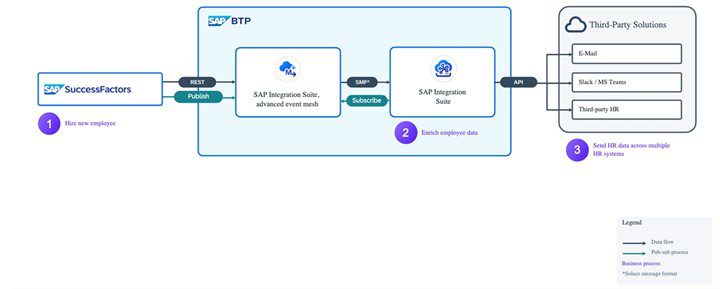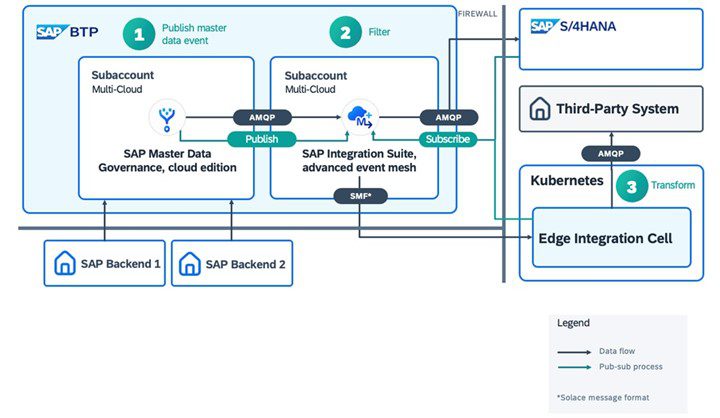Home > Blog > For Architects
This is the first in a series of blog posts that explores why SAP customers should embrace event-driven architecture (EDA) and how SAP Integration Suite, advanced event mesh can support this transformation at every stage of the journey.

Figure 1:E2E EDA flow powered by AEM and EP
In this first part, I will explain why enabling events on SAP platforms is crucial, and how effective event governance and management play a critical role in ensuring a successful transition to event-driven architecture.
The second installment of this series will delve into the event portal within SAP Integration suite, advanced event mesh, focusing on its compatibility with AsyncAPI, the process of generating AsyncAPI specifications for both standard and custom SAP events, and the steps to import these specifications into the event portal.
Subscribe to Our Blog
Get the latest trends, solutions, and insights into the event-driven future every week.
Thanks for subscribing.
Finally, the last part will highlight how SAP integration architects, developers, and product managers can leverage the event portal to discover and access business-critical events across various business lines in a governed manner. We will also explore how to drive innovation by using the extensible nature of the Event Portal to generate high-quality scaffolding code, facilitating integration with other systems, including SAP Cloud Platform Integration (CPI) and third-party platforms, both SAP and non-SAP.
Why SAP Customers Should Embrace EDA
As organizations advance their digital transformation, the ability to respond in real-time has become both a necessity and an advantage. EDA empowers systems to react instantly to events, enhancing agility, responsiveness, and integration. For SAP customers, adopting EDA is a strategic move that enables greater efficiency and faster innovation.
Agility and Responsiveness
EDA decouples processes in SAP environments, allowing systems to respond immediately to business events like sales orders, inventory changes, or IoT alerts from SAP IoT services on the SAP Business Technology Platform (BTP). This agility helps SAP customers quickly adapt to market changes and reduce time-to-market.
Scalability in a Cloud-First World
EDA offers scalability that aligns with modern SAP environments, enabling systems to handle increased event volumes by scaling horizontally. Unlike traditional SAP ECC systems that struggle with peak loads, EDA ensures efficient event processing during high-demand periods, such as seasonal sales, keeping systems responsive and efficient for global markets with fluctuating demand.
Seamless Integration with Hybrid Environments
In today’s hybrid IT landscapes, SAP systems like S/4HANA, SAP Ariba, and SAP SuccessFactors coexist with non-SAP applications, such as third-party cloud services, various integration platforms, and custom-built software. EDA facilitates seamless integration between these diverse systems by enabling loose coupling, eliminating the need for complex and tightly coupled interfaces. For example, SAP ECC can integrate smoothly with third-party logistics (3PL) providers, enabling real-time tracking and updates in the SAP Transportation Management module to enhance supply chain efficiency.
Real-Time Decision-Making
EDA enables real-time decision-making by streaming business events from SAP modules (such as SAP S/4HANA, SAP BW/4HANA, or SAP C/4HANA) into a central data warehouse for analysis. This approach allows businesses to derive actionable insights and make dynamic adjustments. For instance, an SAP-based retailer could modify pricing and promotional strategies in real-time based on live sales data and customer behavior, optimizing revenue and customer satisfaction.
Supporting Digital Transformation
EDA is a cornerstone of digital transformation within the SAP ecosystem. By fostering flexible, responsive, and data-driven architectures, EDA enables SAP customers to innovate rapidly and bring new services to market faster. Whether it involves deploying AI-driven predictive maintenance or enhancing personalized customer experiences, EDA positions SAP customers to meet the demands of the digital age.
What is SAP Integration Suite, Advanced Event Mesh
SAP Integration Suite, advanced event mesh (AEM) is a scalable, enterprise-grade platform that enables EDA within SAP ecosystems. It enables real-time event distribution across SAP and non-SAP applications, facilitating seamless integration, improved data flow, and efficient event management.
Some of its key features:
- Event Brokering: AEM dynamically routes events across SAP modules (e.g., SAP S/4HANA, SAP Ariba) and external systems, ensuring timely data delivery.
- Multi-Cloud Support: It integrates SAP solutions across different cloud providers and on-premises systems, offering flexibility in deployment.
- Reliability: AEM guarantees high availability and fault tolerance, critical for managing business processes without interruption.
- Security: Advanced security features like encryption and role-based access control protect sensitive data during event transmission.
- Monitoring: Built-in analytics provide real-time visibility into event flows, helping optimize performance.
- Event Management and Governance: Provides centralized management and governance of EDA artifacts including fine grained access controls, policy enforcement, auditing and tracking across multiple brokers and environments.
Case Studies
Let’s look at some interesting situations where companies used SAP Integration Suite, advanced event mesh as the backbone of EDA initiatives:
HR Integration for Enhanced Employee Experience
An international company using SAP SuccessFactors faced challenges integrating HR data with other SAP systems and non-SAP applications like payroll, benefits, and communication tools due to differing data formats and real-time requirements
By using Advanced Event Mesh as the EDA backbone, the company enabled seamless integration between SAP SuccessFactors and external systems. When a new employee is onboarded, a “new employee” event is published, triggering automatic workflows such as IT access provisioning, payroll updates, benefits enrollment, and welcome communications. This real-time integration speeds up onboarding, maintains consistency, and enhances the employee experience.

Figure 2:Event based HR integration
Source
Streamlined Order-To-Cash Flow in a Webshop
An e-commerce company using SAP Commerce Cloud needed a more responsive order-to-cash (OTC) process. The existing system suffered from latency issues during high-traffic periods, causing order delays and customer dissatisfaction.
The company implemented Advanced Event Mesh to decouple order management from backend operations. An “order placed” event triggers downstream processes—inventory checks in SAP S/4HANA, fraud detection, and fulfillment coordination—without direct API calls. This setup ensures real-time communication, reduces bottlenecks, and improves order processing speed, enhancing customer experience and scalability during peak sales.

Figure 3:Event enabled OTC flow
Source
Master Data Distribution Across the Enterprise
A global manufacturing firm needed accurate master data (customer, supplier, product) synchronized across multiple SAP and non-SAP systems, including SAP S/4HANA, SAP MDG, CRM platforms, and legacy systems. Discrepancies in data updates led to inefficiencies and reporting errors.
Advanced Event Mesh provided an event-driven master data distribution framework. When master data is updated in SAP MDG, events are published across the mesh, allowing all subscribed systems to instantly consume and synchronize the data. This reduces delays and errors, ensuring all systems have current data, thereby improving decision-making and operational efficiency.

Figure 4: Event powered MDM
Source
Different Types of Events in SAP Ecosystem
Standard Events
Standard events in SAP S/4 HANA are generated based on predefined triggers such as the creation or update of sales orders, delivery notes, or invoices. Traditionally these events carried minimal data, typically just an ID or reference, and notify other systems that an action has occurred, but SAP has started to enrich some events with additional data in their payload thereby improving their utility for downstream processes
As core components of the SAP system, standard events ensure consistency and reliability across modules and versions. For instance, a sales order event includes a sales order ID and timestamp, notifying the warehouse for shipping preparation and triggering a confirmation email to the customer.
The SAP Business Accelerator Hub (formerly SAP API Business Hub) is a platform offering a central repository of APIs, pre-built integrations, and event specifications. Events in this hub are standard notifications from SAP S4/Hana and are not customizable. They include:
- Standard Business Events: Related to common processes like order creation, invoice posting, and delivery updates.
- Industry-Specific Events: Tailored to industries such as retail, manufacturing, and healthcare.

Figure 5: SAP Business Accelerator Hub for events
Source
User-Defined Events
User-defined or custom events in SAP are created based on specific business needs, triggered by custom logic or unique business processes not covered by standard events. They feature rich payloads, providing comprehensive data in one go, thus reducing the need for additional data retrieval.
These events offer flexibility, allowing businesses to tailor them to specific requirements, including complex conditions and detailed data structures. They facilitate seamless integration with both SAP and non-SAP systems, enhancing interoperability and robust data exchange workflows.
Custom events also enable organizations to fully leverage event-driven architecture (EDA) principles, ensuring optimal real-time data propagation and processing. For instance, a high-value Order processed event might trigger when a sales order exceeds a predefined value, alerting the sales team and finance department, and initiating a VIP customer follow-up process.
SAP ECC and its EDA Challenges
SAP ECC customers face a greater challenge than S/4Hana customers in adopting EDA, mainly because of its modular monolithic design and focus on batch processing and synchronous transactional processing.
How Asapio Addon Can Help
Asapio Integration for SAP AEM addresses these challenges by event-enabling SAP ECC applications. This ASAPIO module provides enhanced event handling, simplified data modeling and transformation, middleware reduction, performance optimization and enhances scalability.
Using the SAP Integration add-on for AEM helps ECC customers align their systems with modern EDA standards with only configuration – no ABAP coding required. This enhances current capabilities and eases the transition to S/4HANA in the future.

Figure 6: Asapio Integration for SAP AEM
Source
Effective Event Management and Governance in SAP EDA Adoption
Adopting EDA in an SAP environment enhances agility, responsiveness, and integration, but it takes strong event management and governance across several organizational roles to realize these benefits.
As SAP architects and stakeholders navigate the complexities of modern, real-time data processing, it is essential to establish robust governance frameworks that address several key aspects:
- Data Quality and Consistency: Governance ensures accurate, consistent data flow across SAP and non-SAP systems, supporting reliable decision-making.
- Security and Compliance: Strong governance enforces data protection, access controls, and compliance with regulatory standards.
- Performance Optimization: Proper management of event flows helps prevent bottlenecks, optimizing system responsiveness.
- Monitoring and Observability: Real-time insights into event performance enable proactive issue resolution and continuous improvement.
- Scalability and Flexibility: Governance supports scalability by defining clear standards for event management, ensuring the architecture adapts to future needs.
- Interoperability: Effective governance facilitates seamless integration and reduces complexity across diverse systems.
An Alternative: SAP Application Interface Framework
SAP Application Interface Framework (AIF) is a tool within the SAP ecosystem that facilitates the integration and monitoring of data exchanges between different SAP systems and external applications. SAP AIF provides a flexible framework for managing, monitoring, and troubleshooting data interfaces, helping businesses streamline their integration processes. SAP AIF helps event-enable SAP ECC instances by allowing creation of custom events, transforming and mapping data and implementing event triggers.
Summary and What’s Next
For SAP customers pursuing digital transformation, adopting EDA is essential for enhancing agility, scalability, integration, and real-time decision-making. EDA decouple processes in SAP environments so systems can respond rapidly to business events and market changes, thereby supporting seamless integration across diverse IT landscapes and fostering innovative, data-driven strategies.
SAP Integration Suite, advanced event mesh boosts EDA capabilities by providing a robust integration and streaming platform that ensures efficient event distribution across SAP and non-SAP applications. Its features have been successfully utilized in diverse scenarios, such as improving HR integration, optimizing e-commerce order flows, and maintaining consistent master data across global systems.
Adopting EDA requires effective event management and governance, especially for SAP ECC customers who face integration challenges. Solutions like the Asapio Integration for SAP AEM and SAP AIF help align older systems with modern EDA standards, enhancing scalability and performance. With a coordinated effort among roles such as enterprise architects, integration architects, business analysts, and developers, SAP customers can maximize the benefits of EDA to accelerate digital innovation and achieve strategic goals.
In the next part of this blog series, I will take a closer look at the event portal within the SAP Integration Suite, advanced event mesh. I’ll explore how it seamlessly integrates with AsyncAPI, enabling you to design and manage your event-driven architecture more efficiently. You’ll learn how to generate AsyncAPI specifications for both standard and custom SAP events and discover how to import these specifications into the event portal to unlock new opportunities for streamlined event management.
Explore other posts from category: For Architects

Hari is a dynamic, creative, and innovative professional who is always looking for a challenge and understand different software development processes from both technical and business perspectives.
His main background is Software Engineering in Java, Microservices and EDA. DevOps and Agile is more about who he is and how he does things and cooperates with people.
Hari’s current focus is on evaluating emerging technologies, practices, frameworks and identifying how they can best serve the long-term interests and ambitions of my clients.
He is passionate about how programming can be a key participant in sustainability discussions, identifying points for consideration while making technology choices from a green perspective.


Subscribe to Our Blog
Get the latest trends, solutions, and insights into the event-driven future every week.
Thanks for subscribing.
